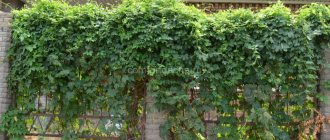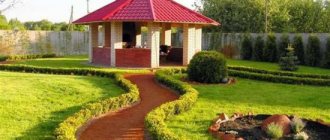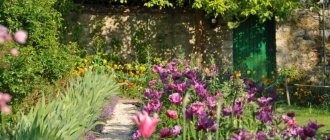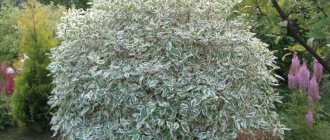Many summer residents ask what kind of flowers to plant near the fence so that they not only look good, but also grow well. I made a selection of garden flowers - the most unpretentious ones, which are perfect for creating such plantings. Most of them do not need to be watered at all; they can easily withstand shade and are not picky about the quality of the soil. The selection includes annuals and perennials, medium and tall in size, blooming throughout the season and combined with each other - you can choose for every taste and for a fence from any material.
Amaranth
An unpretentious annual blooming with small purple flowers collected in spike-shaped paniculate inflorescences. The plant is very bright with rich leaf color. It can be successfully used in the landscape of any site. It will look very good as a hedge along the fence. Amaranth can also be planted in the background of mixed flower beds.
Tall flowers
Of the tall flowers, you should pay attention to the following crops:
- Sunflower. Fits perfectly into the country style landscape. Light-loving but frost-resistant plant. Remains decorative throughout the season.
- Floribunda roses. Very colorful, have long continuous flowering.
- Gladioli. They tolerate shade well. Characterized by bright, colorful blooms throughout the season.
Related article:
What to plant in the shade: plants for flower beds
Bush aster
A perennial that blooms profusely in the fall and delights with its flowering until frost. Unpretentious, grows quickly, does not require special care. The basket inflorescences come in different colors: white, blue, pink, purple and others. Also, the height of the plant depends on the variety. Low-growing ones can be used for hedges, tall ones can be planted in the background of flower beds.
Bush aster (Sentyabrinki)
RUB 220.00
Coniferous plants
Often it is most preferable to plant coniferous plants near the fence - they will decorate the fence in winter and summer. However, it is necessary to choose the most stable and unpretentious species.
Mountain pine
A coniferous shrub (rarely a tree), mountain pine (Pinus mugo) is characterized by slow growth. Pine cones are ovoid, shiny brown, 3-6 cm long. The needles are dark green and short. Mountain pine is not very demanding on soil; it can grow on calcareous and peaty soils, dry and wet. However, for good growth it needs a well-lit place; it is a light-loving plant.
Mountain pine is very resistant to harsh weather conditions and can survive cold winters. It looks beautiful next to a fence and can be used to create an evergreen hedge. It is often used to strengthen slopes, it protects the soil from erosion and landslides. If the fence has a steep slope, mountain pine is ideal.
Juniper
The juniper genus includes several dozen species. Right after pine trees, it is the most common type of coniferous tree in the world. There is a wide variety of juniper varieties, from columnar forms that are usually planted along fences, to trailing varieties that work well as groundcovers. Most junipers have hard and prickly needles, but there are also species whose shoots are covered with small green scales. Due to their low habitat requirements, junipers do not require special care. During long periods of drought, they should be watered, with maintenance treatments limited to fertilization and occasional pruning.
Suitable for planting near a fence:
- Chinese juniper (Juniperus chinensis),
- Common juniper (Juniperus communis),
- Juniper medium (Juniperus x media),
- Cossack juniper (Juniperus sabina).
Thuja
A thuja hedge will perfectly complement any fence; it will protect from prying eyes and dust. Western thuja variety "Smaragd" is often planted. This is one of the best and most popular thujas with a conical shape, ideal for a hedge. It is characterized by moderately strong growth - after 10 years it grows up to 2.5 meters, the annual growth is about 30 cm. The plant has a conical regular shape and a bright green (almost emerald) color of the needles, which does not change even in winter.
Thujas are planted at a distance of 60-80 cm, in fertile soil. The place should be sunny or slightly shaded. You can trim the tops of the thuja so that all plants have the same height.
Black pine
Black pine (Pinus nigra) grows slowly, reaching 10 m in about 30 years. She has an upright, slender form. The needles are long (8-15 cm), hard, collected in bunches in pairs. The cones are symmetrical, ovoid in shape. Black pine has low requirements, is easy to grow, loves sunny positions, and grows well in partial shade. It grows even on sandy, poor soils; limestone soils are better suited. In the first years of cultivation, it is recommended to water (especially in winter - in moderately warm weather). It is worth feeding with compost, manure and calcium fertilizers
Black pine is highly resistant to air pollution and soil salinity. Tolerates frosts and strong winds well. It can be planted in cities, on the streets. It works well when planted in groups as a green wall to provide protection from strong winds. The tree is used for landscaping industrial areas and strengthening soils.
Spruce
The coniferous tree spruce (Picea) is characterized by a dense conical crown, a height (wild) of more than 30 m, and thin cracked gray-brown or brown-gray bark. It grows quickly: up to 50 cm per year, after 10 years it can reach 4 m. The needles of blue spruce are prickly, green or silver-gray. The crown is regular, conical in shape. Long-lived plant. Spruce is undemanding to soil and grows even on very dry sandy or heavy soils. It needs a sunny position, it grows poorly in the shade, the crown is less branched.
The plant is easy to grow, frost-resistant, unpretentious. Tolerates polluted air, drought, pruning, and shaping well. Spruce is often planted in parks and city gardens. It can also be used for hedges to protect the area from dust, noise, and excessive sunlight.
Brunner
An herbaceous perennial that blooms with small sky-blue flowers. Small inflorescences rise beautifully above large dark green leaves. Brunnera flowers are very similar to forget-me-nots. An absolutely unpretentious, shade- and moisture-loving perennial. Suitable for planting in borders, along paths and fences on the shady side.
Brunnera macrofolia
RUB 220.00
Buzulnik
A tall perennial that blooms with pale yellow flowers collected in paniculate inflorescences. Its beautiful heart-shaped leaves are greenish-purple in color. The plant pleases with its flowering all summer. The decorative crop looks great near rocky fences, ponds or in mixed flower beds. Loves abundant watering. If you have a damp, shaded corner in your dacha, the buzulnik will like it there.
Buzulnik Othello
RUB 450.00
Calendula
Marigold or calendula is a representative of the genus of herbaceous plants of the Asteraceae family.
The height of the plant ranges from 20 to 70 cm, the diameter can reach 70-80 cm. The bushes are pubescent, spreading, with light green ribbed shoots and smooth oval leaves.
The outer part of calendula flowers is formed by large reed petals of a flat, elongated shape, rich yellow or bright orange. In the center there is a core or small tubular petals, painted in darker yellow-orange shades.
The flowering period of calendula is extended over time: the first buds open by the end of May, mass flowering begins in June and lasts until November.
Gaillardia
A tall, long-flowering perennial with shoots pubescent on the upper part. Single inflorescences on long stems produce beautiful red-purple flowers. Flowering begins in spring and continues all summer, which is good news. Lush gaillardia bushes look great in flower beds near fences made of any material. This unpretentious flower looks great both in mono and group plantings.
Gaillardia perennial
RUB 200.00
Fencing a flower bed from scrap materials
The finished look of the flower bed along the fence is given by borders, which are easy to decorate with your own hands:
- from pegs driven into the ground and intertwined with willow vines;
- made of bricks laid diagonally on top of each other in a shallow groove;
- from old car tires, cut into long strips that are used to intertwine metal pegs;
- from plastic bottles, cut in half and driven upside down into the ground;
- from planks of different heights dug into the ground;
- from driftwood, cleared of bark, polished and laid around the perimeter of the flowerbed.
Important! Wooden elements are treated with an antiseptic or painted.
A flower bed along the fence attracts attention and serves to visually delineate the space of the yard and the street. A flower garden made in accordance with all the rules of landscape design can hide the shortcomings of the fence and protect the private territory from noise, wind and prying eyes.
Heliopsis
A tall perennial that blooms with bright yellow or orange flowers. A vigorous bush with abundant dark green foliage and beautiful daisy-like flowers. Will decorate any summer cottage with its appearance. Looks good if planted along a high stone fence. Fits perfectly into the background of any flower bed. Easy to care for, drought-resistant, undemanding to soil quality.
Heliopsis perennial
RUB 350.00
Dahlias
Perennial and annual dahlias will look good on the site along a fence made of any material. Depending on the variety, the beautiful caps of the inflorescences are painted in a variety of colors and shades. This unpretentious plant will delight you with its flowering until the first frost. Grows well in both shade and sun. Tall varieties can be planted in the background of flower beds, medium-height varieties can be used to make improvised hedges, and low-growing dahlias look great in the foreground of flower beds.
Delphiniums - flowers along the fence with a height of 1 to 2-3 m
For many, these are problematic flowers: they do not sprout well from seeds. I went shopping in March and saw the roots being sold. So planting material can be found.
Gardeners especially like New Zealand ones.
New Zealand Pink Blush
But you can plant both Germanic and Pacific hybrids along the fence. The assortment of delphiniums is large: there are low ones, one meter high, and 2 meters high.
Delphiniums near the fence
Perennial delphiniums bloom in two waves: at the beginning of summer and at the end, if you cut off the flower stalks early after the first flowering.
I myself have not yet cared for adult flowering ones, I grew mine from seeds last year, and are overwintering for the first time. But judging by the comments, gardeners are divided into two camps: the first says that delphiniums are difficult to grow, and the second says that they are problem-free and grow on their own.
Delphiniums grow well in sunny places protected from the wind. The scorching sun can burn the leaves, therefore, as for phlox, shade that protects from the midday sun for at least 2-3 hours is desirable.
Delphinium
Sun-loving, drought-resistant perennial. A tall, unpretentious plant blooms with double flowers of various shades. Admires the unusual shape of the inflorescences. Delphiniums often become the central elements of flower arrangements surrounded by other perennials. Look good in group plantings along high fences. It blooms in mid-summer; if you cut off the inflorescences and feed them, you can achieve repeated flowering.
goldenrod
A well-leafed perennial that blooms with rich yellow flowers collected in paniculate inflorescences. An unpretentious, sun-loving plant will be a good decoration for any summer cottage. Blooms in July and blooms until autumn. Looks impressive in group mono-plantings along fences and walls of outbuildings. Drought-tolerant goldenrod will grow and bloom in any conditions without causing you any problems.
goldenrod
RUB 220.00
Trees
When choosing trees to plant along the fence, you should take into account that their branches do not extend into the neighboring territory and do not disturb the neighbors. The following crops meet these requirements:
- Columnar fruit trees (apple trees, plums, pears, etc.). They are planted at 2m intervals, creating a natural barrier, while providing an excellent fruit harvest in summer and autumn.
- Tui. They are considered a universal fence. They tolerate even strong pruning into various shapes, so they can be located almost right next to each other.
- Ate. They grow slowly and retain their rich color throughout the year. But you need to choose dwarf varieties (Ordinary spruce, Prickly or Gray spruce).
Cosmea
Decorative garden perennial. An unpretentious, drought-resistant plant that blooms with pink or white flowers. It will be a good option for decorating flower beds and for growing in gardens near fences or buildings. This elegant flower will decorate any area of your summer cottage. It grows very well, forming tall lush bushes. It pleases with its flowering all season long.
Phlox paniculata - a beautiful classic
There is nothing easier than growing phlox. And they bloom for a long time: on my site they show off from July to September.
This is my first old phlox. I dug up a root for planting from my mother’s garden.
My phlox paniculata without a name
Last year I bought the pink variety Graf Zeppelin. It was already blooming the year it was planted.
Phlox Graf Zeppelin against the background of tarragon
Phlox grows by rhizomes. 3-4 years after planting, the bush can already be divided into several seedlings.
I don’t really take care of it in any way, except for the field.
Phloxes by the fence
The best place for planting is open to the sun, but hidden in the hot afternoon hours by a tree or fence. The soil should be moist.
Kupena
A tall, unpretentious perennial with unusually beautiful leaves. It blooms with many small snow-white flowers located along the entire length of the stem. This plant is often called garden lily of the valley. Kupena loves diffused dim light and high humidity, so it is perfect for planting along fences on the shady side. In such conditions, the moisture-loving kupena will reveal itself in all its glory and will delight you with lush thickets until the fall.
Kupena
RUB 350.00
What to plant along the fence if it is in the shade?
When choosing seedlings for planting near the fence, consider the plants' preferences for light and shade. It is better to place flowers with delicate leaves, as well as shade-loving crops, in the shade of the fence.
Coniferous trees can be planted in the shade: yew and fir. These plants are tall, but can be easily trimmed to adjust the crown shape and height after planting and decorate the area.
Yew
Hydrangea and elderberry seedlings in a flower garden, if planted in the shade, do not require loosening. Therefore, you can plant them in the far corners of the site near the fence.
Elder
You can also plant seedlings with red rowan berries and lilac bushes in a flower garden in the shade near a private fence.
Rowan
It’s clear what trees and bushes to plant in the flower garden near the fence. All that remains is to decide on the plants. Proper planting and care in the future will allow you to decorate the fence with the help of different plants and make the site attractive in any season.
Lupine
Low decorative perennial. Lupine inflorescences are racemose, surprising with their beauty and variety of flowering shades. They come in white, red, purple, yellow, cream, white, pink. From a variety of shades you can create a beautiful flower arrangement that will attract the eye. You can make a beautiful hedge from the unpretentious sun-loving lupine, or simply plant it in a mixed flowerbed, laid out in any corner of your summer cottage.
Types of flower beds for decoration
Thoughtful landscape design near the fence will turn empty strips of land into bright flower arrangements.
Mixborder, border and ridge
There are several types of flower beds, the structure of which differs, despite the external similarity:
- Mixborder is a multi-tiered flower bed of flowers and shrubs, smoothly turning into a lawn. The tallest plants are planted on the first tier near the fence, the middle level is occupied by medium-sized plants, and ground cover and dwarf crops are placed on the lower level. Plants in a mixborder are selected according to their flowering time from spring to late autumn, ensuring the decorative appearance of the area near the fence throughout the warm season.
- Rabatka is a rectangular flower bed with one or two or three types of flowers, planted in parallel lines or a repeating pattern in one or two tiers.
- A border is a strip of low-growing shrubs (boxwood) that tolerate pruning well, or beautifully blooming low flowers (irises, marigolds).
Attention! Mixborders and rabatka are similar in appearance, but rabatka is characterized by strict geometric planting; mixborders are made in a freer form, closer to the natural style of flower bed design.
Mallow
A perennial with a powerful leafy stem dotted with many flowers. Comes in different shades. It grows into a huge bush that is impressive in its appearance. Flower beds and group flower beds planted near the fence will perfectly complement the site. In mono-plantings it can act as a hedge. The flower is unpretentious, sun-loving, and drought-resistant. An absolutely unpretentious plant that grows well in any conditions.
If the fence is made of chain-link mesh
Chain-link mesh is a traditional design option for fencing suburban areas. It is cheap, easy to use and quite durable. In addition, its installation takes minimal time and effort, and its service life is quite long.
A big advantage is the lack of darkening, as with most materials used for fences, so almost all options are suitable for decorating the space under the fence. Another popular solution is to plant climbing plants that form a living “wall” and, in the summer, also delight with the appearance of flowers in such a garden.
Among the most popular design options are:
- Hop. This is a fast-growing plant, the main disadvantage of which is the absolute monopolization of the territory. To prevent this from happening, it is necessary to trim the branches regularly, and it is advisable to limit the planting site with slate remains or any other fencing.
Hops by the mesh fence - Beans. Planting this crop requires care, but you will get rid of the need to tie up the stems.
Beans - Ivy . Some species of this plant are specially grown instead of decorative hedges.
- Honeysuckle . Excellent decoration and rapid growth guarantees complete isolation of your site from prying eyes.
- Acacia . These plantings grow well in any conditions, creating an excellent additional fence.
When choosing weaving plants, it should be taken into account that the load on the mesh will increase noticeably. For this purpose, additional supports are erected so that the fence simply does not break under such plant pressure. Typically, perennial crops require periodic thinning, but in the case of annuals, you can change the appearance of the hedge every season.
Rudbeckia
Tall perennial. Rudbeckia flowers are very beautiful, have a black core dotted with numerous yellow stamens. Blooms deep yellow. It will be a wonderful addition to a flower bed in a summer cottage. The plant is unpretentious, sun-loving, so it can grow in any corner of the garden. Along the fence it will look spectacular in group plantings with other perennials.
Zinnias
An annual flowering in single inflorescences-baskets on long stems. Above the beautiful leaves rise no less beautiful flowers, painted in different shades: from white to purple-red. An unpretentious plant will be an excellent option if planted along the fence. It also looks good in a flower bed in group plantings.
Whatever your fence, you can choose suitable flowers for it that do not require special care and bloom all season long. Such flower beds can become a decoration for any summer cottage. With annuals, you can try different options every year. And with perennials, plant them once and enjoy the blooms every year.
Shrubs
Shrubs can be used as an independent hedge, or you can decorate an existing fence with them. Use varieties of the same size but different colors. Don't forget about shaping the crowns so that your fence is always beautiful and tidy.
Derain
This is the most popular shrub for planting along fences because it is easy to trim and holds its shape well. Derain has an unusual silvery color, and it also gets along with other varieties without any problems. Such a fence reliably protects from dust if there is a road on the other side. And the turf grows quickly and literally grows by a whole meter in just six months.
Photo: mykaleidoscope.ru
Barberry Thunberg
The main advantage of this type is its wonderful appearance. Globular bushes with large matte leaves grow up to 90 cm. In autumn they acquire a delightful red-yellow hue and do not fly around for a long time. But remember that Thunberg barberry does not like drafts, cold wind and shade.
Photo: pokrovdvor64.ru
Hydrangea
For landscaping along a fence, paniculate hydrangea with large lush inflorescences is best suited. It grows as a large loose bush up to 2-3 meters, and can be given any shape. The tree-like hydrangea with its dense greenish balls-inflorescences is also good.
Photo: flo.discus-club.ru
Chubushnik
It is not for nothing that mock orange is called the double of jasmine, but at the same time it is much less capricious and more resistant to our latitudes. The perennial ornamental shrub tolerates harsh winters well, and with the beginning of flowering it delights with a delicate jasmine aroma and snow-white inflorescences. In compositions along the fence, mock orange goes well with hydrangea, because it belongs to the same family.
Photo: prorastet.ru
Spirea
Spiraea is a beautiful ornamental shrub with bright large leaves and unusual pubescent inflorescences. It is absolutely unpretentious, it does not need to be constantly fertilized and watered, and it coexists well with other plants. Spiraea bushes can be shaped or left as is - they grow beautifully without pruning.
Photo: pinterest.ru
Lilac
Lilac is valued for its beauty, aroma and variety of shades - it will become a real decoration of the area along the fence. Amur lilac is considered the most frost-resistant, while the rest are more demanding of heat. All species require good lighting, low groundwater levels and regular care.
Photo: da4nik.ru
Elder
In our latitudes, elderberry is often found on the side of paths and country roads. This means that it is also great for landscaping areas along the fence. Black elderberry has dozens of ornamental varieties with multi-colored leaves and increased productivity. The bushes are very moisture-loving, but at the same time very hardy.
Photo: goldvoice.club
Currant
Currant bushes are quite difficult to take root, but then they delight you with their beauty, aroma and useful harvest. They are planted at a distance of about half a meter and formative pruning is carried out in the spring. Currants love the sun, loosening the soil and root watering. After 15 years, the bushes will have to be renewed.
Photo: akaoray.ru
Blackberry
If you want to plant berry bushes along the fence, but don’t have time for constant care, choose blackberries (or raspberries). She is very unpretentious and will delight you with a rich harvest every year. Just keep in mind that both species reproduce quickly and fill the entire area. Keep an eye on this and don't let the branches touch the ground.
Photo: m.fotostrana.ru
Boxwood
The most popular evergreen shrub for creating garden sculptures is boxwood. It is used by landscape designers around the world as a main element and as a complement to the composition. Boxwood grows slowly: on the one hand, at first you will have to be patient, and on the other hand, later you will not need to thin out and shorten the crowns every season.
Photo: selsov.ru
Flowers similar to lilies: names and photos (catalog)










